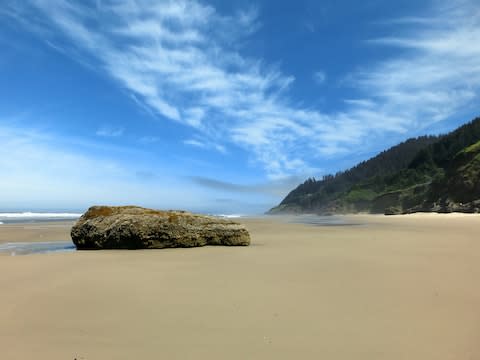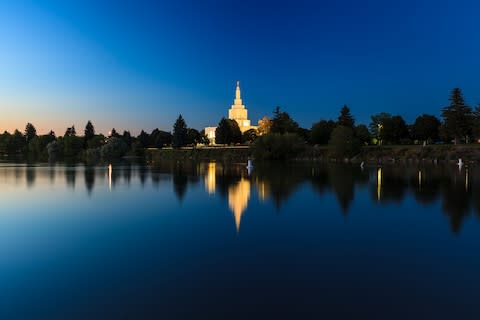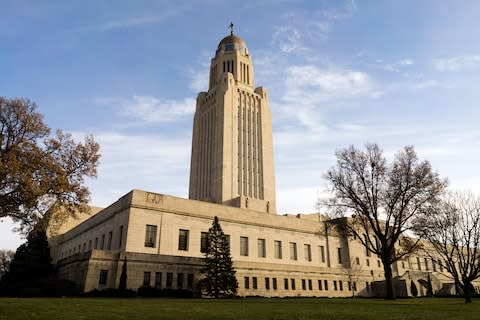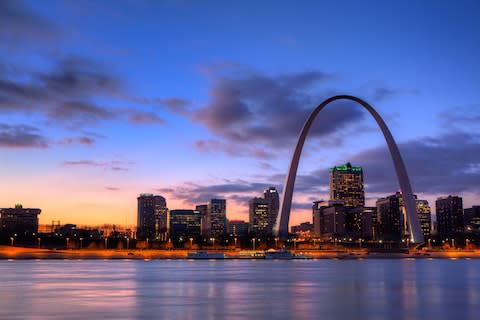10 amazing places in America to watch the 2017 solar eclipse

You might call it an act of time travel. Few things reduce us to medieval yeomen, gazing in awe at the heavens as the moon positions itself between us and the sun, like a total eclipse.
Another edition of this relatively rare celestial event is imminent - although you will need to leap across the Atlantic to experience it.
What creates a total solar eclipse
August 21 will see the USA take global centre stage as moon and sun perform their dance - a tango that will arc right across the nation, from east to west; a 90-minute (or thereabouts) spectacle which will be the first of its kind in the country (discounting Hawaii) in 38 years. People are getting rather excited about it.
While the eclipse will be visible, to some extent, right across North America, the crux of the matter will be the "path of totality" - a corridor, 70 miles wide, in which the blackness will be impervious.
Where and when to see the eclipse
This will start its journey on the Pacific coast, with the moon's shadow striking Oregon at 9.05am local time, and totality being achieved at 10:16am. It will then curve east and south-east, touching 14 states, before bidding farewell to American soil at Charleston, South Carolina, at 2.48pm east-coast time (the shadow will linger to 4:09pm).
The joy of this eclipse, in terms of travel, is that it makes for an excellent reason to glimpse some of the less heralded portions of the USA. Fourteen states may be on the itinerary, but none of them (with the exceptions of Tennessee, Illinois and, perhaps, Wyoming) are staples of American holidays.
California? No thanks. New York? Not this time, my good fellow. Florida? I'm afraid not. Instead, the likes of Idaho, Nebraska, Missouri and South Carolina will have a season in the sun (or, at least, the absence of it). And the following 10 places may be ideal base camps for the big show...
1. Lincoln Beach (Oregon)
What: The starting grid for it all. This small coastal community, where Oregon meets the world's biggest ocean, will be the point where the eclipse "makes land". It sits about two thirds of the way up the state's western edge, a simple drive from the biggest city, Portland.

What to see post-eclipse: Lincoln Beach is as good a place as any to witness America's relationship with the Pacific - a pretty spot with a clifftop lighthouse. The adjacent Fogarty Creek State Recreation Area (oregonstateparks.org) is a fine location to stroll on the sand.
More information:traveloregon.com
2. Salem (Oregon)
What: The Oregon capital. Not to be confused with Salem, Massachusetts (of witch-trials fame) - nor Portland, which is a far larger city, yet is not state kingpin. The Oregon capitol building - a somewhat odd affair topped by a gold statue of a pioneer - is the proof of this.

What to see post-eclipse: Salem is even closer to The City (48 miles south of it). With claims to being the hipster capital of America (though Austin might dispute this), Portland is worth a few days of your time, not least the Pearl District and its warehouse art galleries.
More information:travelportland.com; explorethepearl.com
3. Idaho Falls (Idaho)
What: An underappreciated slice of the American north-west, Idaho attracts few visitors from outside US borders. But this nugget of a town in the south-east of the state is easy to reach (it has its own airport) - and the cascade in question, on the Snake River, is a delight.

What to see post-eclipse: Drive some 90 miles west and you can slip into the volcanic wonderland that is Craters of the Moon National Monument and Preserve - a safeguarded expanse of cracked soil and labyrinthine lava tubes (nps.gov/crmo) that looks wholly lunar.
More information:visitidaho.org
4. Casper (Wyoming)
What: Wyoming's second biggest city is a place of cowboy lore and sturdy stirrups. Which means that, if this is your bag, you can take in the holler and hurrah of the rodeo while in town - the Sankey Eclipse Rough Stock Rodeo (visitcasper.com) is planned for August 20.
What to see post-eclipse: It is something of a drive (about 275 miles north-west), but the geysers and glories of Yellowstone National Park (nps.gov/yell) are an unmissable part of Wyoming - as is the adjacent rocky landscape of Grand Teton National Park (nps.gov/grte).
More information:travelwyoming.com
Total solar eclipse 2017: explainer
5. Lincoln (Nebraska)
What: Nebraska falls into that section of the USA - its agricultural heart - which is only for tourists most fascinated by all things American. That said, Lincoln is the state capital, and its capitol building is a triumph of the form - a Gothic Revival tower rising above K Street.

What to see post-eclipse: It is but a 50-mile hop north-east to Omaha, Nebraska's biggest city, where attractions include the Strategic Air Command & Aerospace Museum (where exhibits include a stealthy SR-71A Blackbird, the planet's fastest plane; sacmuseum.org).
More information:visitnebraska.com; visitomaha.com
6. St Louis (Missouri)
What: One of the major cities of the Midwest, St Louis comes imbued with a geographic grandeur thanks to its position on the west bank of the River Mississippi. The presence of the 630ft (192m) Gateway Arch (gatewayarch.com) adds to the idea of a city of substance.

What to see post-eclipse: Take a drive up-river (120 miles north-west) to Hannibal - the childhood home of Mark Twain, and setting for his tales of Tom Sawyer and Huckleberry Finn. The Mark Twain Boyhood Home & Museum (marktwainmuseum.org) is found here.
More information:visithannibal.com; explorestlouis.com; visitmo.com
7. Paducah (Kentucky)
What: Tucked into the very south-west of Kentucky, Paducah clings to the rural spirit of a state which is decidedly short on urban sprawl. This "city" of 25,000 people could never be described as a metropolis as it stares calmly across the River Ohio at neighbouring Illinois.
What to see post-eclipse: Some of America's leafiest vistas. You can cross the state line to absorb Shawnee National Forest in Illinois (fs.usda.gov/shawnee), or hang out in Kentucky to explore Land Between The Lakes National Recreation Area (landbetweenthelakes.us).
More information:kentuckytourism.com; enjoyillinois.com
US cities to visit
8. Nashville (Tennessee)
What: Probably the most famous dot on the solar eclipe's route map, Tennessee's capital is the centreground of country music, and underlines this at the Country Music Hall of Fame (countrymusichalloffame.org), where Johnny Cash and Dolly Parton are suitably serenaded.
What to see post-eclipse: You can catch live country music at venues both large (the Grand Ole Opry; opry.com) and small (the hallowed Ryman Auditorium; ryman.com) - or dance the night away at riotous Broadway bars like Tootsies Orchid Lounge (tootsies.net).
More information:visitmusiccity.com; tnvacation.com
9. Columbia (South Carolina)
What: A city which is anticipating the solar eclipse with gusto. Columbia will greet the darkening of the firmament via the Total Eclipse Weekend (totaleclipsecolumbiasc.com) - a celebration which will encompass food, music and even an "Art in the Dark" exhibition.
What to see post-eclipse: South Carolina's capital is one of those exciting mid-sized cities at which America excels. It has a vibrant restaurant scene in its Congaree Vista district. The Motor Supply Co. Bistro (motorsupplycobistro.com), in a former garage, is a case in point.
More information:discoversouthcarolina.com; columbiacvb.com
10. Charleston (South Carolina)
What: The endgame for the eclipse (pretty much; the "path of totality" will pass just to the north), Charleston is also, famously, a hub of heritage when it comes to the American Civil War. Fort Sumter, where the first shots were fired, in 1861, is just off-shore (nps.gov/fosu).

What to see post-eclipse: Charleston is a historic maze, one of America's oldest cities (founded in 1670). Its story shines in the Edmondston-Alston House, a fine slab of 19th century Southern architecture (edmondstonalston.com) - and in the stalls of its City Market.
More information:thecharlestoncitymarket.com; charleston.com
At a glance | Future solar eclipses in the UK

